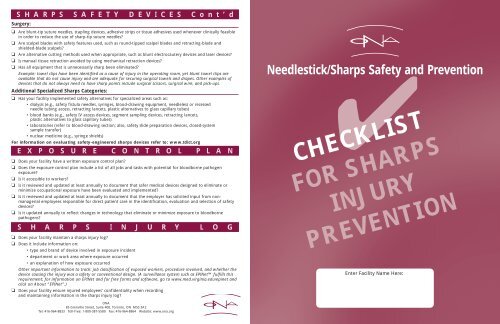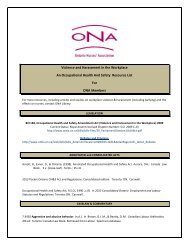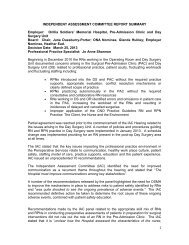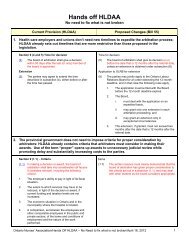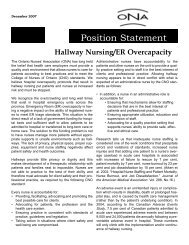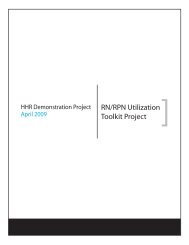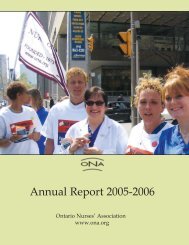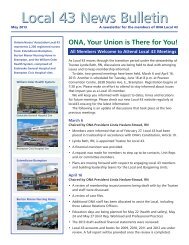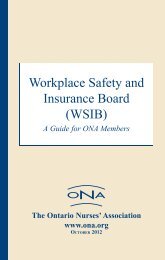ONA Safety Checklist for Sharps Injury Prevention
ONA Safety Checklist for Sharps Injury Prevention
ONA Safety Checklist for Sharps Injury Prevention
You also want an ePaper? Increase the reach of your titles
YUMPU automatically turns print PDFs into web optimized ePapers that Google loves.
S H A R P S S A F E T Y D E V I C E S C o n t ’ d<br />
Surgery:<br />
❏ Are blunt-tip suture needles, stapling devices, adhesive strips or tissue adhesives used whenever clinically feasible<br />
in order to reduce the use of sharp-tip suture needles<br />
❏ Are scalpel blades with safety features used, such as round-tipped scalpel blades and retracting-blade and<br />
shielded-blade scalpels<br />
❏ Are alternative cutting methods used when appropriate, such as blunt electrocautery devices and laser devices<br />
❏ Is manual tissue retraction avoided by using mechanical retraction devices<br />
❏ Has all equipment that is unnecessarily sharp been eliminated<br />
Example: towel clips have been identified as a cause of injury in the operating room, yet blunt towel clips are<br />
available that do not cause injury and are adequate <strong>for</strong> securing surgical towels and drapes. Other examples of<br />
devices that do not always need to have sharp points include surgical scissors, surgical wire, and pick-ups.<br />
Additional Specialized <strong>Sharps</strong> Categories:<br />
❏ Has your facility implemented safety alternatives <strong>for</strong> specialized areas such as:<br />
• dialysis (e.g., safety fistula needles, syringes, blood-drawing equipment, needleless or recessed<br />
needle tubing access, retracting lancets, plastic alternatives to glass capillary tubes)<br />
• blood banks (e.g., safety IV access devices, segment sampling devices, retracting lancets,<br />
plastic alternatives to glass capillary tubes)<br />
• laboratories (refer to blood-drawing section; also, safety slide preparation devices, closed-system<br />
sample transfer)<br />
• nuclear medicine (e.g., syringe shields)<br />
For in<strong>for</strong>mation on evaluating safety-engineered sharps devices refer to: www.tdict.org<br />
E X P O S U R E C O N T R O L P L A N<br />
❏ Does your facility have a written exposure control plan<br />
❏ Does the exposure control plan include a list of all jobs and tasks with potential <strong>for</strong> bloodborne pathogen<br />
exposure<br />
❏ Is it accessible to workers<br />
❏ Is it reviewed and updated at least annually to document that safer medical devices designed to eliminate or<br />
minimize occupational exposure have been evaluated and implemented<br />
❏ Is it reviewed and updated at least annually to document that the employer has solicited input from nonmanagerial<br />
employees responsible <strong>for</strong> direct patient care in the identification, evaluation and selection of safety<br />
devices<br />
❏ Is it updated annually to reflect changes in technology that eliminate or minimize exposure to bloodborne<br />
pathogens<br />
S H A R P S I N J U R Y L O G<br />
❏ Does your facility maintain a sharps injury log<br />
❏ Does it include in<strong>for</strong>mation on:<br />
• type and brand of device involved in exposure incident<br />
• department or work area where exposure occurred<br />
• an explanation of how exposure occurred<br />
Other important in<strong>for</strong>mation to track: job classification of exposed workers, procedure involved, and whether the<br />
device causing the injury was a safety or conventional design. (A surveillance system such as EPINet fulfills this<br />
requirement; <strong>for</strong> in<strong>for</strong>mation on EPINet and <strong>for</strong> free <strong>for</strong>ms and software, go to www.med.virginia.edu/epinet and<br />
click on About “EPINet”.)<br />
❏ Does your facility ensure injured employees’ confidentiality when recording<br />
and maintaining in<strong>for</strong>mation in the sharps injury log<br />
Needlestick/<strong>Sharps</strong> ✔<strong>Safety</strong> and <strong>Prevention</strong><br />
CHECKLIST<br />
FOR SHARPS<br />
INJURY<br />
PREVENTION<br />
Enter Facility Name Here:<br />
<strong>ONA</strong><br />
85 Grenville Street, Suite 400, Toronto, ON M5S 3A2<br />
Tel: 416-964-8833 Toll-free: 1-800-387-5580 Fax: 416-964-8864 Website: www.ona.org
S H A R P S S A F E T Y D E V I C E S<br />
In addition to the <strong>Checklist</strong>, the Joint Health and <strong>Safety</strong> Committee (JHSC)<br />
should be doing regular reviewing and act upon reports of<br />
Needlestick/<strong>Sharps</strong> Injuries.<br />
This checklist is a modified version of one developed by the International<br />
Healthcare Worker <strong>Safety</strong> Center, University of Virginia. The original<br />
document was intended to assist facilities in complying with the sharps<br />
safety requirements of the Occupational <strong>Safety</strong> & Health Administration<br />
(OSHA’s) Bloodborne Pathogens Standard of 2001.<br />
The checklist provides a valuable reference on the best practices <strong>for</strong><br />
sharps safety and needlestick prevention. Once completed, it should be<br />
used in conjunction with the best practices document to establish the<br />
minimum recommendations in writing from the JHSC to the employer.<br />
Topics not covered in the checklist include: work practice controls; personal<br />
protective equipment; disposal containers; housekeeping and laundry;<br />
laboratories; hepatitis B vaccination; post exposure protocol; and<br />
communication of hazards to employees.<br />
In implementing these new requirements, keep in mind two key principles<br />
in needlestick/sharps prevention:<br />
(1) Eliminate unnecessary needles and sharps wherever possible. Needles<br />
used to connect IV lines or access IV ports are a common type of<br />
unnecessary needle. Also look at the OR, where blunt-tip suture needles<br />
may be substituted <strong>for</strong> sharp ones in many cases, and at clinical labs, where<br />
needles and syringes are sometimes used as lab tools.<br />
(2) Give priority to implementing safety blood-drawing and vascular<br />
access devices, since injuries from these devices have the highest risk of<br />
pathogen transmission.<br />
All devices designed to prevent blood exposures should be<br />
closely monitored <strong>for</strong> user and patient safety.<br />
Blood-drawing:<br />
❏ Has your hospital or facility implemented blood-drawing devices with integrated safety features designed to<br />
prevent percutaneous injuries<br />
Examples of such devices include:<br />
• shielded or self-blunting needles <strong>for</strong> vacuum tube phlebotomy;<br />
• shielded, retracting or self-blunting butterfly-type needles, syringes with a cylindrical sheath that shields<br />
needles when injecting blood into tubes;<br />
• blood gas syringes with a hinged-needle shield that can be put in place over the needle using a<br />
hands-free technique.<br />
❏ Have all unnecessary needles been eliminated from use, including needles used <strong>for</strong> drawing blood from<br />
intravenous, arterial, and central lines, which can be replaced by needleless or blunt cannula devices<br />
❏ Does your facility use automatically-retracting finger/heelstick lancets in place of manual lancets or non-retracting<br />
spring-loaded lancets<br />
❏ Has your facility switched from glass to plastic micro-bore capillary tubes <strong>for</strong> measuring hematocrit (or to mylarwrapped<br />
glass capillary tubes, or alternative methods of measuring hematocrit that do not require capillary<br />
tubes) See Joint <strong>Safety</strong> Advisory issued by FDA, OSHA and CDC, in February 1999.<br />
❏ Has your facility replaced glass blood collection vacuum tubes with plastic tubes<br />
❏ Have blood-drawing personnel been advised not to manually recap or remove needles from<br />
blood-drawing devices<br />
❏ Have blood-drawing personnel been advised not to reuse blood tube holders, which requires manipulation of a<br />
blood-filled needle<br />
❏ Has the practice of injecting blood through a stopper into a vacuum tube using an exposed needle<br />
been discontinued<br />
Methods of drawing blood directly into vacuum tubes or other specimen containers should be preferentially<br />
employed; alternatively, safety syringes with a cylindrical needle shield locked in place over the needle, which<br />
allow a vacuum tube to be inserted into the shield during blood injection, will reduce the risk of needlesticks<br />
and of blood splatter from dislodged tube stoppers.<br />
Vascular Access:<br />
❏ Has your facility implemented safety vascular access catheters that provide a protective shield <strong>for</strong> the stylet or<br />
blunt the stylet be<strong>for</strong>e or during its withdrawal from the patient<br />
IV Infusion:<br />
❏ Has your facility converted to needleless or recessed needle IV infusion systems<br />
An FDA <strong>Safety</strong> Alert warned in 1992 of the dangers associated with “piggyback”or “intermittent IV” line<br />
connections. Since then, almost two-thirds of U.S. hospitals have switched to needleless or recessed needle<br />
systems. But beware: in some hospitals both systems – needleless/recessed needle and needle-based - are<br />
sometimes provided side by side. Hospitals should eliminate needles used to access IV ports.<br />
Injection:<br />
❏ For syringes used <strong>for</strong> subcutaneous or intramuscular (IM) injections, has your facility converted to devices that<br />
have integrated safety features such as sliding sleeves, retracting needles, or hinged caps, or to a needleless<br />
injection system<br />
❏ Does your facility specify that syringes should not be used <strong>for</strong> venous blood drawing, because of increased<br />
needlestick risk<br />
❏ Has your facility eliminated the inappropriate use of conventional or safety syringes <strong>for</strong> accessing ports of<br />
needleless or recessed needle IV systems<br />
❏ Does your facility use safety-designed prefilled syringes, where available, <strong>for</strong> vaccinations and other applications<br />
where prefilled syringes are employed


